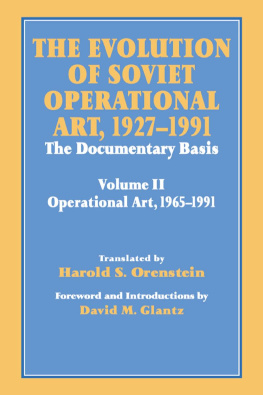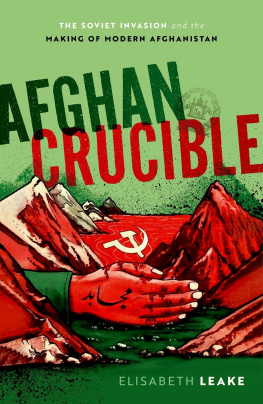
This edition is published by PICKLE PARTNERS PUBLISHINGwww.picklepartnerspublishing.com
To join our mailing list for new titles or for issues with our books picklepublishing@gmail.com
Or on Facebook
Text originally published in 2000 under the same title.
Pickle Partners Publishing 2014, all rights reserved. No part of this publication may be reproduced, stored in a retrieval system or transmitted by any means, electrical, mechanical or otherwise without the written permission of the copyright holder.
Publishers Note
Although in most cases we have retained the Authors original spelling and grammar to authentically reproduce the work of the Author and the original intent of such material, some additional notes and clarifications have been added for the modern readers benefit.
We have also made every effort to include all maps and illustrations of the original edition the limitations of formatting do not allow of including larger maps, we will upload as many of these maps as possible.
AFGHANISTAN AND BEYOND: REFLECTIONS ON THE FUTURE OF WARFARE
by
Stephen J. Blank
FOREWORD
This report provides an historical analysis of lessons from one of the most important wars of the 1980s, the war in Afghanistan. After reading this study, you will better understand the nature of operations other than war in multiethnic states. Many fear that these wars will set the paradigm for wars in the 1990s and will exert pressure on U.S. forces to conduct peacekeeping, peace-enforcement and humanitarian assistance operations in especially dangerous areas. Yugoslavia and Somalia, each in their own way, bear out the ubiquity of these wars and the pressures on the United States to act.
This report will, of course, contribute to the body of material dealing with the war in Afghanistan. More importantly, it increases understanding of future wars, particularly these types of wars, so that policymakers and analysts alike will better appreciate their military and political aspects. In turn, we may devise mechanisms either to forestall and avert them, or to bring them to the speediest possible conclusion. Alternatively, should those mechanisms fail and troops have to be committed, this and future analyses will enable commanders to have a better grasp of the nature of the war they will fight. In either case, understanding the war and the theater should facilitate a solution more in keeping with U.S. interests and values.
TABLE OF CONTENTS
Contents
TABLE OF CONTENTS
REQUEST FROM THE PUBLISHER
BIOGRAPHICAL SKETCH OF THE AUTHOR
STEPHEN J. BLANK has been an Associate Professor of Russian/Soviet Affairs at the Strategic Studies Institute since 1989. Prior to this appointment Dr. Blank was Associate Professor for Soviet Studies at the Center for Aerospace Doctrine, Research, and Education of Air University at Maxwell Air Force Base. Dr. Blanks M.A. and Ph.D. are in Russian history from the University of Chicago. He has published numerous articles on Soviet military and foreign policies, notably in the Third World, and is the author of a forthcoming study of the Soviet Commissariat of Nationalities and editor of books on Soviet foreign policies in Latin American and on the future of the Soviet military.
EXECUTIVE SUMMARY
Many military analysts believe or fear that the wars of the 1990s will be akin to the wars in the former Yugoslavia: small-scale but long-lasting and recurrent ethnic wars that also elude easy international resolution. There are consequently well-founded concerns about prospects for deployment of U.S. forces there in a unilateral or U.N. capacity. Some of the lessons of this kind of war were already apparent in the wars of the 1980s. They were known then as low-intensity conflicts and now as operations other than, or short of, war.
This report focuses mainly on lessons from one of the most crucial of these wars, i.e., in Afghanistan as a result of the Soviet invasion in 1979, and attempts to draw lessons that are relevant for current wars, like those in Yugoslavia or the ex-Soviet Union. The purpose is to stimulate analysis and reflection on the strategic and operational, if not also tactical nature of these wars by both analysts and policymakers so that all interested groups can more easily come to terms with a form of warfare that promises to be both deeply destructive and deeply rooted in longstanding political and social antagonisms that cannot be easily or quickly resolved.
Naturally some of the lessons drawn from Afghanistan and other wars may either only apply to Russian and Soviet forces or conversely may apply to war in general. But our primary intention is to make a contribution to the study of future wars particularly of the ethnic and small-scale type that promise to continue in many parts of the globe lest we devise better ways for averting and then resolving them.
AFGHANISTAN AND BEYOND: REFLECTIONS ON THE FUTURE OF WARFARE
The Initial Period of the Afghan War and Low-Intensity Conflict.
The Soviet war in Afghanistan may fairly be seen as the first rock in the avalanche that culminated in the collapse of the USSR. Therefore the analysis of its lessons and those of the subsequent conflicts of the 1990s in Yugoslavia, the Transcaucasus and Moldova are of interest. These lessons suggest new trends in the small-scale but no less terrible wars of the present, even those having nothing to do with the former Soviet Union.
It is only as a result of Afghanistan that Russian generals came to consider the American terms of low-intensity conflict (henceforth LIC) and counterinsurgency. Before 1991 those terms and their implications had no meaning for Soviet commanders and were attacked by Soviet writers. {1} In the Soviet context, Afghanistan was:
a war in defense of a socialist revolution menaced by a combination of internal counterrevolutionaries and external patrons: Pakistan, the United States, Iran, China, and Saudi Arabia. As such it was a coalition war, particularly after 1980-81.
It also was, in theater terms, a Local war in a mountain-desert theater of war ( Teatr VoinyTV ). That is, it took place in a single country or region and TV . (Some analysts might restrict the dimension of the war to a mountain desert area but Afghanistan and contiguous border areas as well as Pakistan and the USSR experienced military operations, however small scale, a fact that justifies use of the term, TV ) . Moreover, the Soviets had extensively prepared this theater and studied it topographically, ethnically, economically, and graphically. They paid considerable attention to the road networks, to the seizure of key economic regions and resources, and to transportation infrastructures. Indeed, just as in Iran in 1941, Soviet strategy aimed to maximize access to these key targets in its strategy. Hence the invasion of Afghanistan had a pronounced combined arms character and stressed simultaneous and gradual insertion of air and ground troops along key axes as in 1941. {2}
It was also an asymmetric or limited war in the sense that the Soviet Union fought a limited war while its allies and the Mujahedin fought a more or less total war. {3} By limited war we mean that both the scale of operations and forces that Moscow committed were strictly limited. Of course, for the resistance what was at stake was the future of their country--a total war objective. Hence the asymmetry between them.










